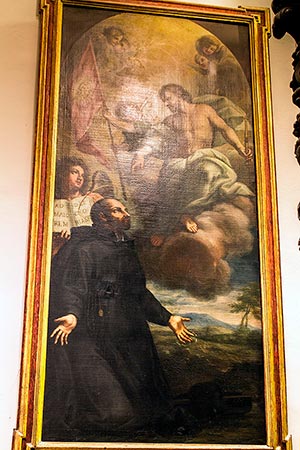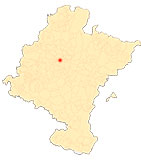Basilica of St. Ignatius of Loyola
By Ricardo Fernández Gracia
|
|
|
|
|
|
|
|
|
|
|
|
|
|
|
|
|
|
|
|
|
|
|
|
|
|
|
|
|
|
|
|
|
|
|
The decoration: Roman paintings
Some canvases and objects of worship from the Indies, the Court of Madrid and Rome
The two ancient collaterals were dedicated to Saint Ignatius, watching over the arms before the Virgin of Montserrat, and to Saint Francis Xavier, interceding for the plague-stricken. The first of these has been preserved. On the walls of the temple hang some interesting paintings such as the saint in armor, sent around 1715 from Rome by Brother Emeterio Montoto who, years before, had been in the care of the young Jesuits in Villagarcía. It is a copy of another painting conserved in San Ignacio in Rome. Of the same provenance is the large landscape canvas of the fall of the saint, sent in 1729 by Father Manuel de la Reguera (1668-1747), private theologian of Cardinal Belluga. The composition is an exact copy of the one found in the vaults of the church of St. Ignatius in Rome, the work of Father Pozzo (1685-1686).
Other paintings also arrived from the Eternal City, a large one of the saint before the Risen Christ, a couple of St. Ignatius, and two smaller ones of St. Aloysius Gonzaga and St. Stanislaus of Kostka, all framed in 1749. The apparition of the Risen Christ is, in reality and as Father Javier Sagüés has pointed out to me, the approval of the name of the Society with the approval of Christ himself, back in 1537. Father Juan Antonio Polanco, from Burgos, secretary of St. Ignatius and of the Society, wrote a chapter graduate De Societatis Jesu nomine, in the context of before the arrival in Rome, in Vicenza, in September 1537, where the question of the name was proposed:
While they were discussing among themselves what they would call themselves to whoever would ask them which congregation was theirs, they began to pray and to think about what name would be more convenient, and, seeing that they had no head among themselves nor any other superior but Jesus Christ, whom they only wished to serve, it seemed to them that they should take the name of the one whose head they had, calling themselves the Society of Jesus. And in this matter of the name, Father Master Ignatius had so many visitations of the one whose name they took and so many signs of his approval and confirmation of this surname, that I heard him say to the same one that he would think of going against God and offending him if he doubted that this name was suitable (MHSI. Polanci, Fontes narrativi I, 204).
Among other gifts, we will highlight: two gilded chalices, sent from Potosí by Tomás Rodríguez in 1719; a silver Jesus sent in 1722; a chalice from the royal confessor, Father Rubinet, in 1709; a silver reliquary, paid for by President Juan de Loyola; intaglio plates to stamp images of the Heart of Jesus; amounts in cash by Father Juan José Eraso from Chile in 1750; 782 pesos by the Indian from Puente la Reina, Francisco Miguel de Gambarte, in 1767....
file Diocesan of Pamplona. Government of the Diocese. administrative office de Cámara. Boxes 293, 294, 295, 296 and 297.
ASCUNCE, E., Íñigo de Loyola, capitán español, y el castillo de Pamplona, Madrid, Aguado, 1939.
AZANZA LÓPEZ, J., La arquitectura religiosa del Barroco en Navarra, Pamplona, Government of Navarre, 1998.
EGUILLOR, J. R., Loyola, historia y arquitectura, San Sebastián, Etor, 1991.
FERNÁNDEZ GRACIA, R., El retablo barroco en Navarra, Pamplona, Government of Navarre, 2003.
FERNÁNDEZ GRACIA, R., "The Jesuits in Pamplona 1580-1767". Diario de Navarra, 28 April 2014, pp. 70-71.
FERNÁNDEZ GRACIA, R., "Heritage and identity (52). The basilica of San Ignacio in Pamplona". Diario de Navarra, 21 May 2021, pp. 62-63.
GARCÍA GAÍNZA, M.ª C. et al., Catalog Monumental de Navarra V. Merindad de Pamplona ***, Pamplona, Institución Príncipe de Viana, 1997.














